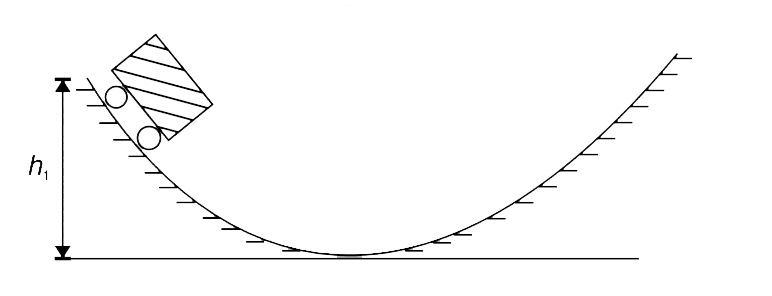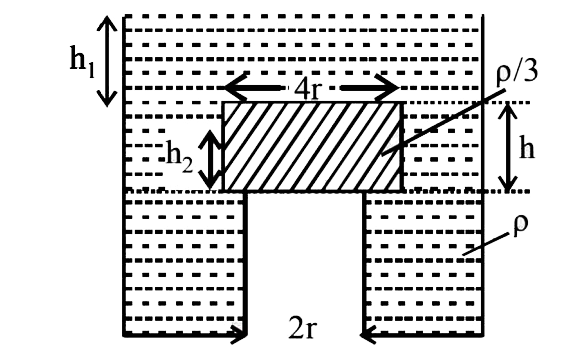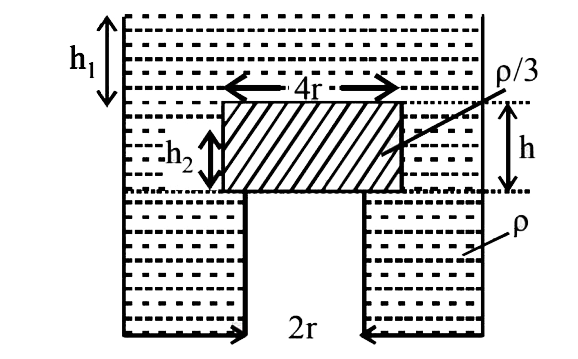A tanker filled with water starts at rest and then rolls, without any energy loss to friction, down a valley. Initial height of the tanker is h1. The tanker, after coming down, climbs on the other side of the valley up to a height h2. Throughout the journey, water leaks from the bottom of the tanker. How does h2 compare with h1?

The correct Answer is:h2=h1
Step by step video, text & image solution for A tanker filled with water starts at rest and then rolls, without any energy loss to friction, down a valley. Initial height of the tanker is h_1. The tanker, after coming down, climbs on the other side of the valley up to a height h_2. Throughout the journey, water leaks from the bottom of the tanker. How does h_2 compare with h_1? by Physics experts to help you in doubts & scoring excellent marks in Class 11 exams.
Updated on:21/07/2023Topper's Solved these Questions
Similar Questions
A breaker contains water, up to a height h1 and kerosene of height h2 above water, so that the total height of ( water + kerosene ) is (h1+h2). Refractive index of water is μ1 and that of kerosene is μ2. The apparent shift in the position of the bottom of the beaker when viewed from above is
View SolutionA cylindrical tank of height H is completely filled with water. On its vertical side there are two tiny holes, one above the middle at a height h1 and the other below the middle at a depth h2 If the jets of water from the holes meet at the same point at the horizontal plane through the bottom of the tank then the ratio h1/h2 is :
View Solution
Knowledge Check
A cylindrical tank has a hole of diameter 2r in its bottom. The hole is covered wooden cylindrical block of diameter 4r, height h and density ρ/3.

Situation I: Initially, the tank is filled with water of density ρ to a height such that the height of water above the top of the block is h1 (measured from the top of the block).
Situation II: The water is removed from the tank to a height h2 (measured from the bottom of the block), as shown in the figure. The height h2 is smaller than h (height of the block) and thus the block is exposed to the atmosphere.
Find the minimum value of height h1 (in situation 1), for which the block just starts to move up?A(a) 2h3B(b) 5h4C(c) 5h3D(d) 5h2A cylindrical tank has a hole of diameter 2r in its bottom. The hole is covered wooden cylindrical block of diameter 4r, height h and density ρ/3.

Situation I: Initially, the tank is filled with water of density ρ to a height such that the height of water above the top of the block is h1 (measured from the top of the block).
Situation II: The water is removed from the tank to a height h2 (measured from the bottom of the block), as shown in the figure. The height h2 is smaller than h (height of the block) and thus the block is exposed to the atmosphere.
In situation 2, if h2 is further decreased, thenA(a) cylinder will not move up and remains at its original positionB(b) for h2=h3, cylinder again starts moving upC(c) for h2=h4, cylinder again starts moving upD(d) for h2=h5, cylinder again starts moving upA cylindrical tank has a hole of diameter 2r in its bottom. The hole is covered wooden cylindrical block of diameter 4r, height h and density ρ/3.

Situation I: Initially, the tank is filled with water of density ρ to a height such that the height of water above the top of the block is h1 (measured from the top of the block).
Situation II: The water is removed from the tank to a height h2 (measured from the bottom of the block), as shown in the figure. The height h2 is smaller than h (height of the block) and thus the block is exposed to the atmosphere.
Find the height of the water level h2 (in situation 2), for which the block remains in its origin) position whithout the application of any external forceA(a) h3B(b) 4h9C(c) 2h3D(d) h
The speed of a homogenous solid sphere after rolling down an inclined plane of vertical height h from rest without sliding is
View SolutionA beaker contains water up to a height h1 and kerosene of height h2 above water so that the total height of (water + kerosene) is (h1+h2) . Refractive index of water is μ1 and that of kerosene is μ2 . The apparent shift in the position of the bottom of the beaker when viewed from above is :-
View SolutionA large tank filled with water to a height h is to be emptied through a small hole at the bottom. The ratio of times taken for the level of water to fall from h to h2 and from h2 to zero is
View SolutionA large tank filled with water to a height h is to be emptied through a small hole at the bottom. The ratio of times taken for the level of water to fall from h to h2 and from h2 to zero is
View SolutionA tank of height H and base area A is half filled with water and there is a small orifice at the bottom and there is a heavy solid cylinder having base area A3 and height of the cylinder is same as that of the tak. The water is flowing out of the orifice. Here cylinder is put into the tank to increase the speed of water flowing out.
After long time, when the height of water inside the tank again becomes equal to H2, the solid cylinder is taken out. then the velocity of liquid flowing out of the orifice (just after removing the cylinder) will be
View Solution
